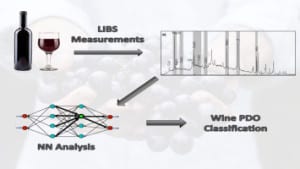S Moncayo, JD Rosales, R Izquierdo-Hornillos… – Talanta, 2016
This work reports on a simple and fast classification procedure for the quality control of red wines with protected designation of origin (PDO) by means of Laser Induced Breakdown Spectroscopy (LIBS) technique combined with Neural Networks (NN) in order to increase the quality assurance and authenticity issues. A total of thirty-eight red wine samples from different PDO were analyzed to detect fake wines and to avoid unfair competition in the market. LIBS is well known for not requiring sample preparation, however, in order to increase its analytical performance a new sample preparation treatment by previous liquid-to-solid transformation of the wine using a dry collagen gel has been developed. The use of collagen pellets allowed achieving successful classification results, avoiding the limitations and difficulties of working with aqueous samples. The performance of the NN model was assessed by three validation procedures taking into account their sensitivity (internal validation), generalization ability and robustness (independent external validation). The results of the use of a spectroscopic technique coupled with a chemometric analysis (LIBS-NN) are discussed in terms of its potential use in the food industry, providing a methodology able to perform the quality control of alcoholic beverages.

… The spectrometer system was an EPP2000, StellarNet (Tampa, FL, USA) with a gated CCD detector. A grating of 300 l/mm was selected; a spectral resolution of 0.5 nm was achieved with a 7 μm entrance slit. The wavelength range used was from 200 to 1000 nm. …





